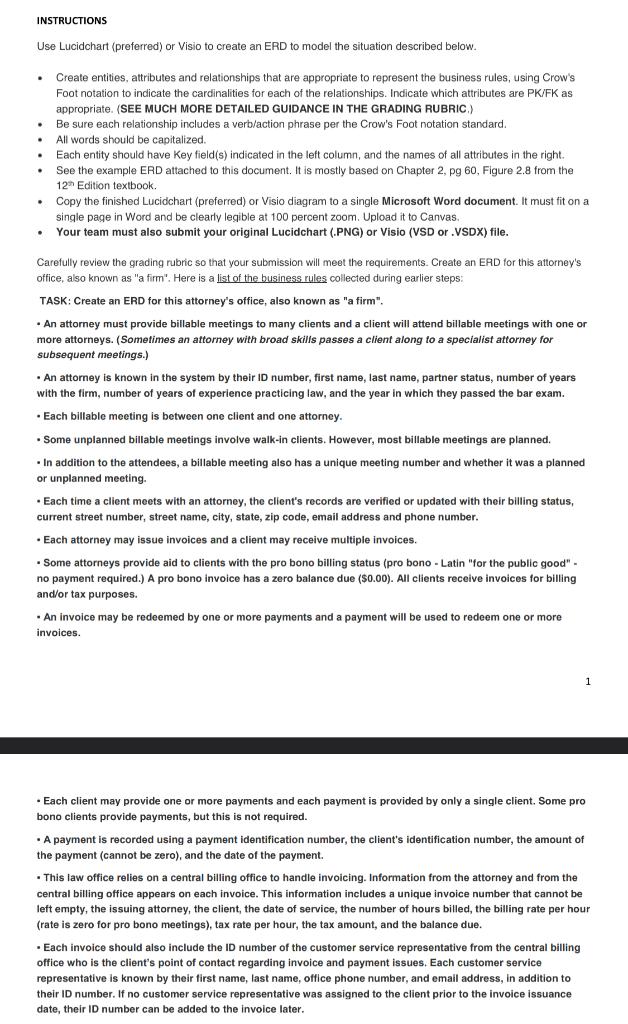TASK: Create an ERD for this attorney's office, also known as "a firm". See the attached photo for more details about the assignment. *** My main question regards the Central Billing Office entity. What attributes should it contain? Should it be combined with the Invoice entity? How does it fit in with the surrounding entities?

Use Lucidchart (preferred) or Visio to create an ERD to model the situation described below. - Create entities, attributes and relationships that are appropriate to represent the business rules, using Crow's Foot notation to indicate the cardinalities for each of the relationships. Indicate which attributes are PK/FK as appropriate. (SEE MUCH MORE DETAILED GUIDANCE IN THE GRADING RUBRIC.) - Be sure each relationship includes a verb/action phrase per the Crow's Foot notation standard. - All words should be capitalized. - Each entity should have Key field(s) indicated in the left column, and the names of all attributes in the right. - See the example ERD attached to this document. It is mostly based on Chapter 2, pg 60 , Figure 2.8 from the 12n Edition textbook. - Copy the finished Lucidchart (preferred) or Visio diagram to a single Microsoft Word document. It must fit on a single page in Word and be clearly legible at 100 percent zoom. Upload it to Canvas. - Your team must also submit your original Lucidchart (.PNG) or Visio (VSD or .VSDX) file. Carefully review the grading rubric so that your submission will meet the requirements. Create an ERD for this attorney's office, also known as "a firm". Here is a list of the business rules collected during earlier steps: TASK: Create an ERD for this attorney's office, also known as "a firm". - An attorney must provide billable meetings to many clients and a client will attend billable meetings with one or more attorneys. (Sometimes an attorney with broad skills passes a client along to a specialist attorney for subsequent meetings.) - An attorney is known in the system by their ID number, first name, last name, partner status, number of years with the firm, number of years of experience practicing law, and the year in which they passed the bar exam. - Each billable meeting is between one client and one attorney. - Some unplanned billable meetings involve walk-in clients. However, most billable meetings are planned. - In addition to the attendees, a billable meeting also has a unique meeting number and whether it was a planned or unplanned meeting. - Each time a client meets with an attorney, the client's records are verified or updated with their billing status, current street number, street name, city, state, zip code, email address and phone number. - Each attorney may issue invoices and a client may receive multiple invoices. - Some attorneys provide aid to clients with the pro bono billing status (pro bono - Latin "for the public good" no payment required.) A pro bono invoice has a zero balance due ( $0.00 ). All clients receive invoices for billing and/or tax purposes. - An invoice may be redeemed by one or more payments and a payment will be used to redeem one or more invoices. - Each client may provide one or more payments and each payment is provided by only a single client. Some pro bono clients provide payments, but this is not required. - A payment is recorded using a payment identification number, the client's identification number, the amount of the payment (cannot be zero), and the date of the payment. - This law office relies on a central billing office to handle invoicing. Information from the attorney and from the central billing office appears on each invoice. This information includes a unique invoice number that cannot be left empty, the issuing attorney, the client, the date of service, the number of hours billed, the billing rate per hour (rate is zero for pro bono meetings), tax rate per hour, the tax amount, and the balance due. - Each invoice should also include the ID number of the customer service representative from the central billing office who is the client's point of contact regarding invoice and payment issues. Each customer service representative is known by their first name, last name, office phone number, and email address, in addition to their ID number. If no customer service representative was assigned to the client prior to the invoice issuance date, their ID number can be added to the invoice later







